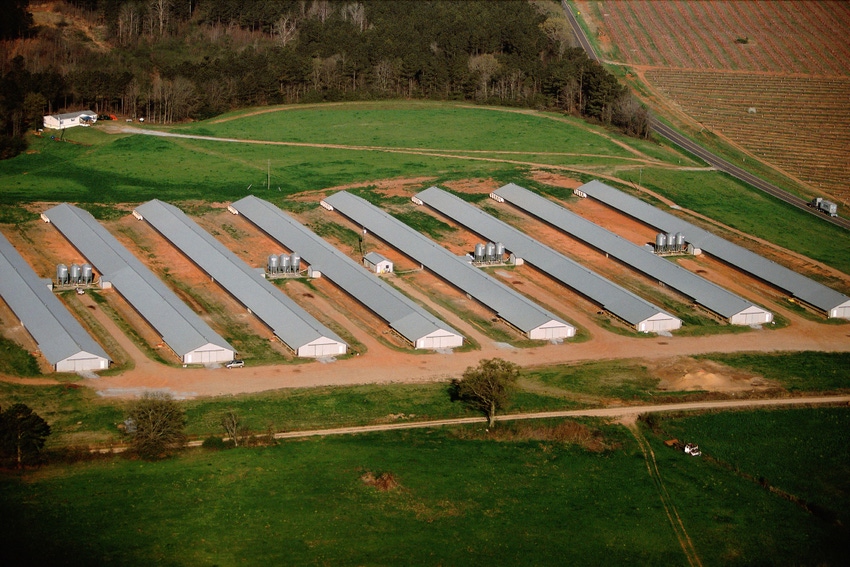Maryland using science-based partnerships to answer questions about air quality near Eastern Shore poultry operations.

The Maryland Department of the Environment (MDE) will sample the air from newly installed monitoring stations on Maryland’s Lower Eastern Shore in answer to ongoing questions regarding the potential effects of large poultry houses on air quality.
MDE said it will collect preliminary data on levels of ammonia and particulate matter near poultry houses for comparison with air quality in other parts of Maryland. The Lower Eastern Shore Ambient Air Quality Monitoring Project will be done under an agreement with the Keith Campbell Foundation for the Environment and Delmarva Poultry Industry Inc. (DPI), which together have committed more than $500,000 to the effort, MDE said.
MDE said it is responsible for technical aspects of the monitoring such as the specification of equipment and the collection and analysis of air monitoring results. This effort is scheduled to continue for one year. At that point, MDE will review results and consider relevant input on any further steps that might need to be taken.
DPI said it is involved because "chicken growers and chicken companies take seriously our responsibility to be responsible stewards of the air, water and land around us. Farm families raising chickens care deeply about air quality on and near their farms; after all, farmers and their neighbors all breathe the same air."
"This is a new kind of collaboration between government, industry and philanthropy that I hope ultimately will improve the health of families and our environment in the region," Campbell Foundation president Samantha Campbell said.
DPI said advances in chicken nutrition, the composition of litter in chicken houses and the increased use of vegetative environmental buffers on family farms where chickens are raised have all made farmers better neighbors when it comes to how their farms affect the air.
The monitoring project will add to what is known about ambient air quality in the areas of Maryland where chickens are raised, DPI noted.
Maryland environment secretary Ben Grumbles said Gov. Larry Hogan's administration "is committed to sound science and environmental leadership in agriculture. This innovative partnership for air quality monitoring will provide useful information to the public.”
Two new monitoring stations will be installed on the Lower Eastern Shore with equipment to measure ammonia and particulate matter while collecting information on weather conditions, MDE said. Establishing the monitors near poultry houses is designed to provide results representative of any effects of concentrations of poultry houses throughout the Eastern Shore.
The specific locations of new stations will depend on an evaluation of factors such as the availability of power, security and proximity to trees and man-made structures that might interfere with the quality of data, MDE said, noting that it will consider the distance between a potential station site and a concentration of poultry houses and homes. The department expects to evaluate these factors over the next few months.
"We, in the chicken community, have a shared interest with all Marylanders in better understanding what air quality is truly like on the Eastern Shore," DPI executive director Holly Porter said. "Because we will never neglect our commitment to environmental responsibility, we believe gathering more data about air quality here helps everyone."
MDE said one of the two new stations will be upwind from poultry houses, and one will be downwind to allow for a comparison. Moreover, equipment to measure ammonia levels will be added to two existing MDE monitoring stations that already measure particulate matter to provide additional “baseline” levels for comparison with the stations near poultry operations. One will be north of the Lower Shore, and one will be on the western shore.
The roles played by MDE, the Campbell Foundation and DPI are spelled out in a memorandum of understanding signed by the parties. Under that memorandum, the Campbell Foundation will pay for the installation of two new air monitoring shelters on the Lower Eastern Shore and provide electrical power and air monitoring devices as specified by MDE. The agreement requires DPI to purchase air sampling devices to measure ammonia at the two existing MDE stations. In addition to collecting data, MDE will prepare a final report summarizing the data collected.
"We firmly believe the air our farmers and their neighbors breathe is healthy and safe, but we also understand why there's skepticism about that from beyond the chicken community," Porter said. "Instead of simply asking for the public's trust that the chicken community's best practices are doing what's right for the environment, we want our families, friends and neighbors to be able to see for themselves what ammonia and particulate matter levels are on the Eastern Shore."
About the Author(s)
You May Also Like

.png?width=300&auto=webp&quality=80&disable=upscale)

